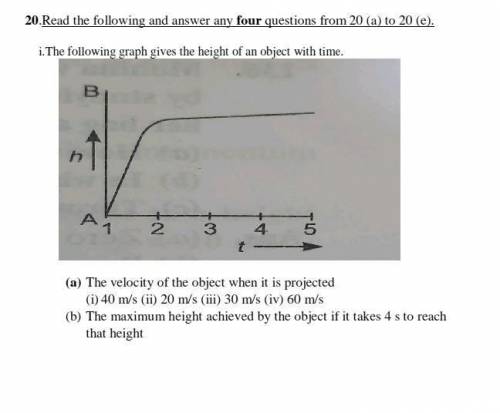
Physics, 28.01.2021 14:00 evere11605
(i) 10 m (ii) 20 m (iii) 40 m (iv) 80 m
(c) The maximum potential energy of the object if its mass is 200g 1 mark
(i) 100 J (ii) 120 J (iii) 160 j (iv) 200 J
(d) In the given graph the total mechanical energy will be 1 mark
(i) Same (ii) increases (iii) decreases (iv) will be zero.
(e) In the given graph the kinetic energy 1 mark
(i) Same (ii) increases (iii) decreases (iv) increases then decreases.


Answers: 1


Other questions on the subject: Physics

Physics, 22.06.2019 08:50, dijonmckenzie3
The electronic structure or chlorine is 2.8.7 what is the electronic structure of fluorine?
Answers: 2

Physics, 22.06.2019 15:30, jonathanmagana112002
Charge is distributed along the entire x-axis with uniform density λ. how much work does the electric field of this charge distribution do on an electron that moves along the y-axis from y = a to y = b? (use the following as necessary: a, b, ε0, λ, and q for the charge on an electron.)
Answers: 3

Physics, 22.06.2019 19:30, rprest00
Amass m = 74 kg slides on a frictionless track that has a drop, followed by a loop-the-loop with radius r = 18.4 m and finally a flat straight section at the same height as the center of the loop (18.4 m off the ground). since the mass would not make it around the loop if released from the height of the top of the loop (do you know why? ) it must be released above the top of the loop-the-loop height. (assume the mass never leaves the smooth track at any point on its path.) 1. what is the minimum speed the block must have at the top of the loop to make it around the loop-the-loop without leaving the track? 2. what height above the ground must the mass begin to make it around the loop-the-loop? 3. if the mass has just enough speed to make it around the loop without leaving the track, what will its speed be at the bottom of the loop? 4. if the mass has just enough speed to make it around the loop without leaving the track, what is its speed at the final flat level (18.4 m off the ground)? 5. now a spring with spring constant k = 15600 n/m is used on the final flat surface to stop the mass. how far does the spring compress?
Answers: 3

Physics, 22.06.2019 22:00, lex1kkkk
The inside surface of a cylindrical-shaped cave of inner diameter 1.0 m is continuously covered with a very thin layer of water. the cave is very long and it is open on both ends. the water on the cave surface is at a constant temperature of 15.5 °c. the cave is constantly exposed to wind such that 15.5 °c air flows through the cave at 4.5 m/s. the kinematic viscosity of the air is 14.66 x 10-6 m2/s and the molecular diffusion coefficient of water vapor in the air is 0.239 x 10-4 m2/s. because the cave diameter is so large, the flow of wind down the length of the cave, in the x direction, can be treated like it is external flow and the cave surface can be approximated as flat where appropriate. calculate the x value, in a) the transition to turbulent flow occurs at rex meters, where the air flow transitions from laminar to turbulent along the inside surface of the cave b) calculate the x value, in meters, where the bulk steady state concentration of water vapor in the air flowing in the cave is 10% of the saturation concentration. assume the air at the surface of the water layer is 100% saturated with water vapor. assume the wind entering the cave contained no moisture before it entered the cave. take into account the transition from laminar to turbulent flow when solving part b
Answers: 1
You know the right answer?
(i) 10 m (ii) 20 m (iii) 40 m (iv) 80 m
(c) The maximum potential energy of the object if its mass...
Questions in other subjects:

English, 26.08.2021 04:40


Mathematics, 26.08.2021 04:40






Arts, 26.08.2021 04:40

French, 26.08.2021 04:40



